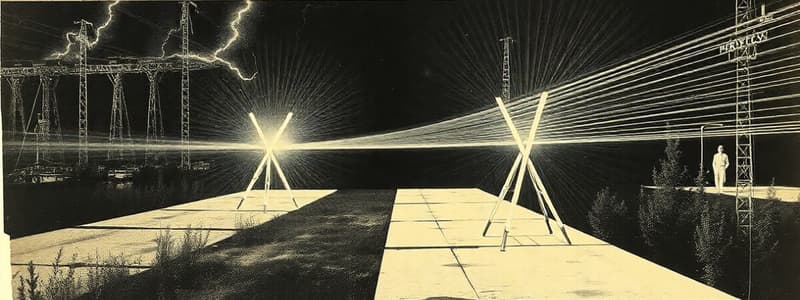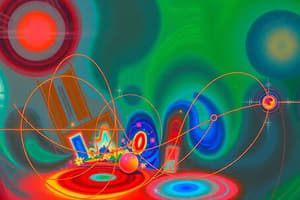Podcast
Questions and Answers
What is the ratio of electrostatic energy stored in X and Y?
What is the ratio of electrostatic energy stored in X and Y?
- 4:1 (correct)
- 1:2
- 1:4
- 2:1
Which of the following is not a cause for power loss in a transformer?
Which of the following is not a cause for power loss in a transformer?
- Improper electric flux sharing
- Eddy currents in the core
- Humming sound from magnetostriction
- Primary coil made of thick copper wire (correct)
When the angular frequency 'w' increases in an R-C circuit, what happens to the bulb's brightness?
When the angular frequency 'w' increases in an R-C circuit, what happens to the bulb's brightness?
- The bulb glows brighter.
- Total impedance increases. (correct)
- Net impedance remains unchanged.
- The bulb glows dimmer. (correct)
For a solid spherical conductor of charge +Q, which statement is correct?
For a solid spherical conductor of charge +Q, which statement is correct?
What quantity remains constant when a battery is connected to a conductor with non-uniform cross section?
What quantity remains constant when a battery is connected to a conductor with non-uniform cross section?
In a straight line plot of terminal potential difference vs current for a cell, what does the slope represent?
In a straight line plot of terminal potential difference vs current for a cell, what does the slope represent?
In a circuit with a fixed amplitude voltage source and varying frequency, which factor primarily affects the capacitor's behavior?
In a circuit with a fixed amplitude voltage source and varying frequency, which factor primarily affects the capacitor's behavior?
What will happen to the potential across the plates of a capacitor if a dielectric slab with dielectric constant ‘K’ is inserted after charging and disconnecting the battery?
What will happen to the potential across the plates of a capacitor if a dielectric slab with dielectric constant ‘K’ is inserted after charging and disconnecting the battery?
Which instrument is best suited for accurately measuring the EMF of a cell?
Which instrument is best suited for accurately measuring the EMF of a cell?
If two wires of the same material are in parallel with lengths and radii in the ratios of 3:2 and 2:3 respectively, what is the ratio of the current passing through the wires?
If two wires of the same material are in parallel with lengths and radii in the ratios of 3:2 and 2:3 respectively, what is the ratio of the current passing through the wires?
How does increasing the temperature affect the specific resistance of a conductor and a semiconductor?
How does increasing the temperature affect the specific resistance of a conductor and a semiconductor?
Why are alloys typically used for making standard resistors?
Why are alloys typically used for making standard resistors?
If a constant voltage is applied across a uniform metallic wire, and another wire of the same material, double the radius and twice the length is used, what will be the heat developed in the new wire?
If a constant voltage is applied across a uniform metallic wire, and another wire of the same material, double the radius and twice the length is used, what will be the heat developed in the new wire?
What happens to the drift velocity of free electrons in a conductor when the potential difference across it is increased to 2V while maintaining constant temperature?
What happens to the drift velocity of free electrons in a conductor when the potential difference across it is increased to 2V while maintaining constant temperature?
Which of the following statements is NOT true regarding equipotential surfaces?
Which of the following statements is NOT true regarding equipotential surfaces?
Where on the x-axis is the net electric field zero due to two point charges +8q and -2q located at x=0 and x=L?
Where on the x-axis is the net electric field zero due to two point charges +8q and -2q located at x=0 and x=L?
What is the work done in rotating an electric dipole moment 'p' by 90 degrees in a uniform electric field?
What is the work done in rotating an electric dipole moment 'p' by 90 degrees in a uniform electric field?
What is the equivalent capacitance of three capacitors 2µF, 3µF, and 6µF connected in series?
What is the equivalent capacitance of three capacitors 2µF, 3µF, and 6µF connected in series?
If two point charges in a dielectric medium experience a force 'F', what will be the force between them in vacuum at the same distance?
If two point charges in a dielectric medium experience a force 'F', what will be the force between them in vacuum at the same distance?
Which statement about Gauss's law is incorrect?
Which statement about Gauss's law is incorrect?
What happens to the electric field inside a uniformly charged parallel plate capacitor?
What happens to the electric field inside a uniformly charged parallel plate capacitor?
How does the electric field within a conductor behave in electrostatic equilibrium?
How does the electric field within a conductor behave in electrostatic equilibrium?
What is the internal resistance of the cell referenced in the content?
What is the internal resistance of the cell referenced in the content?
If a potentiometer wire balances an unknown emf at 6.0 m with a 5 V battery, what is the value of the unknown emf?
If a potentiometer wire balances an unknown emf at 6.0 m with a 5 V battery, what is the value of the unknown emf?
What is the effect on voltage sensitivity when current sensitivity of a galvanometer increases by 20% and resistance increases by 25%?
What is the effect on voltage sensitivity when current sensitivity of a galvanometer increases by 20% and resistance increases by 25%?
When the current in wire A is reversed, what happens to the net force on wire C?
When the current in wire A is reversed, what happens to the net force on wire C?
What is the magnetic moment associated with the orbital motion of an electron in a hydrogen atom moving in an orbit of radius 0.5 Å?
What is the magnetic moment associated with the orbital motion of an electron in a hydrogen atom moving in an orbit of radius 0.5 Å?
What is the average back emf induced across the ends of a switch in an air-cored solenoid when the current is switched off?
What is the average back emf induced across the ends of a switch in an air-cored solenoid when the current is switched off?
The equation for calculating the unknown emf in the potentiometer setup involves what factor related to wire length?
The equation for calculating the unknown emf in the potentiometer setup involves what factor related to wire length?
What happens to the resistance of a galvanometer when its current sensitivity increases by 20%?
What happens to the resistance of a galvanometer when its current sensitivity increases by 20%?
Which statement regarding the forces on a proton and an electron placed between oppositely charged plates is correct?
Which statement regarding the forces on a proton and an electron placed between oppositely charged plates is correct?
What happens to the potential energy of a proton compared to an electron when placed closer to the positive plate?
What happens to the potential energy of a proton compared to an electron when placed closer to the positive plate?
Which statement about transformers and energy transmission is true?
Which statement about transformers and energy transmission is true?
If the secondary coil of a transformer has more turns than the primary coil, what is the behavior of the voltage?
If the secondary coil of a transformer has more turns than the primary coil, what is the behavior of the voltage?
What consequence occurs when a step-up transformer is utilized during power transmission?
What consequence occurs when a step-up transformer is utilized during power transmission?
What is the relationship between the magnetic needle's orientation at the poles and the horizontal component of Earth's magnetic field?
What is the relationship between the magnetic needle's orientation at the poles and the horizontal component of Earth's magnetic field?
When a proton and an electron with the same momenta enter a magnetic field perpendicularly, what can be inferred about their path radii?
When a proton and an electron with the same momenta enter a magnetic field perpendicularly, what can be inferred about their path radii?
Why might increasing the number of turns in a galvanometer not increase its voltage sensitivity?
Why might increasing the number of turns in a galvanometer not increase its voltage sensitivity?
In a uniform electric field, what does the angle θ made by the string indicate about the forces acting on the charged object?
In a uniform electric field, what does the angle θ made by the string indicate about the forces acting on the charged object?
What is the reason that increasing the current sensitivity of a galvanometer does not directly imply an increase in voltage sensitivity?
What is the reason that increasing the current sensitivity of a galvanometer does not directly imply an increase in voltage sensitivity?
What effect does the mass of a charged particle have on its motion in a magnetic field when both particles have the same momentum?
What effect does the mass of a charged particle have on its motion in a magnetic field when both particles have the same momentum?
If a magnetic needle is placed at the equator, how does its orientation differ from that at the poles?
If a magnetic needle is placed at the equator, how does its orientation differ from that at the poles?
In terms of magnetic force impact, how does the same momentum condition for a proton and electron affect their path radius?
In terms of magnetic force impact, how does the same momentum condition for a proton and electron affect their path radius?
Flashcards
Equipotential Surface Property
Equipotential Surface Property
Equipotential surfaces do not intersect, have zero potential change across them, and can be imaginary spheres in a uniform electric field.
Electric field zero point
Electric field zero point
The point on the x-axis where the net electric field due to +8q and -2q point charges is zero.
Work done rotating dipole
Work done rotating dipole
The work done to rotate an electric dipole 90 degrees in a uniform electric field is pE.
Equivalent Capacitance (series)
Equivalent Capacitance (series)
Signup and view all the flashcards
Dielectric Constant effect on force
Dielectric Constant effect on force
Signup and view all the flashcards
Gauss's Law
Gauss's Law
Signup and view all the flashcards
Capacitor Potential Change (Dielectric)
Capacitor Potential Change (Dielectric)
Signup and view all the flashcards
EMF Measurement
EMF Measurement
Signup and view all the flashcards
Current Ratio (Parallel Wires)
Current Ratio (Parallel Wires)
Signup and view all the flashcards
Temperature's Effect (Conductor/Semiconductor)
Temperature's Effect (Conductor/Semiconductor)
Signup and view all the flashcards
Standard Resistor Material
Standard Resistor Material
Signup and view all the flashcards
Heat Development (Wire)
Heat Development (Wire)
Signup and view all the flashcards
Drift Velocity (Voltage Change)
Drift Velocity (Voltage Change)
Signup and view all the flashcards
Ratio of Electrostatic Energy (X, Y)
Ratio of Electrostatic Energy (X, Y)
Signup and view all the flashcards
Transformer Power Loss Cause (Incorrect)
Transformer Power Loss Cause (Incorrect)
Signup and view all the flashcards
Variable Frequency Effect (Capacitor & Bulb)
Variable Frequency Effect (Capacitor & Bulb)
Signup and view all the flashcards
Electric Potential & Field (Spherical Conductor)
Electric Potential & Field (Spherical Conductor)
Signup and view all the flashcards
Constant Quantity (Non-Uniform Conductor)
Constant Quantity (Non-Uniform Conductor)
Signup and view all the flashcards
Voltage Across Resistor (Series Circuit)
Voltage Across Resistor (Series Circuit)
Signup and view all the flashcards
Terminal Potential Difference on Cell
Terminal Potential Difference on Cell
Signup and view all the flashcards
Magnetic needle orientation at poles
Magnetic needle orientation at poles
Signup and view all the flashcards
Horizontal component of Earth's magnetic field at poles
Horizontal component of Earth's magnetic field at poles
Signup and view all the flashcards
Proton and electron paths in magnetic field
Proton and electron paths in magnetic field
Signup and view all the flashcards
Electron Mass vs Proton Mass
Electron Mass vs Proton Mass
Signup and view all the flashcards
Increasing galvanometer turns and sensitivity
Increasing galvanometer turns and sensitivity
Signup and view all the flashcards
Internal Resistance of Cell
Internal Resistance of Cell
Signup and view all the flashcards
Potentiometer Principle
Potentiometer Principle
Signup and view all the flashcards
Current Sensitivity
Current Sensitivity
Signup and view all the flashcards
Voltage Sensitivity
Voltage Sensitivity
Signup and view all the flashcards
Parallel Wires Force
Parallel Wires Force
Signup and view all the flashcards
Orbital Magnetic Moment
Orbital Magnetic Moment
Signup and view all the flashcards
Back EMF in Solenoid
Back EMF in Solenoid
Signup and view all the flashcards
Charge q force
Charge q force
Signup and view all the flashcards
Parallel Plates force
Parallel Plates force
Signup and view all the flashcards
Proton vs Electron Force
Proton vs Electron Force
Signup and view all the flashcards
Potential Energy (proton/electron)
Potential Energy (proton/electron)
Signup and view all the flashcards
Transformer Function
Transformer Function
Signup and view all the flashcards
Step-up transformer
Step-up transformer
Signup and view all the flashcards
Step-down transformer
Step-down transformer
Signup and view all the flashcards
Transformer Power
Transformer Power
Signup and view all the flashcards
Study Notes
General Instructions
- Exam time: 90 minutes
- Maximum marks: 35
- Exam paper contains three sections
- Section A: 25 questions, attempt 20
- Section B: 24 questions, attempt 20
- Section C: 6 questions, attempt 5
- All questions carry equal marks
- No negative marking
Section A
-
Multiple choice questions
-
25 questions, students may choose 20 to attempt
-
For evaluation purposes, only the first 20 answered questions will be assessed
-
Question 1: Properties of equipotential surface.
- Do not cross each other
- Rate of change of potential with distance on them is zero
- For a uniform electric field they are concentric spheres
- They can be imaginary spheres
-
Question 2: Finding a point on the x-axis where the net electric field is zero.
- Charges: +8q and −2q located at x = 0 and x = L respectively.
- Points on x-axis with net electric field of zero:
- 8L
- 4L
- 2L
- L (correct answer)
-
Further questions (Q3-Q7) are multiple choice relating to electric dipoles, capacitors, dielectric constants, and Gauss' law.
Section B
- Multiple choice questions
- 24 questions, students may choose 20 to attempt
- For evaluation purposes, only the first 20 answered questions will be assessed
- Further questions (Q26-Q31) are multiple choice relating to electric field, capacitors, and transformers.
Section C
- Multiple choice questions
- 6 questions, students may choose 5 to attempt
- For evaluation purposes, only the first 5 answered questions will be assessed
- Further questions (Q50-Q55) are multiple choice relating to electric field, electric potential, and transformers.
Studying That Suits You
Use AI to generate personalized quizzes and flashcards to suit your learning preferences.




